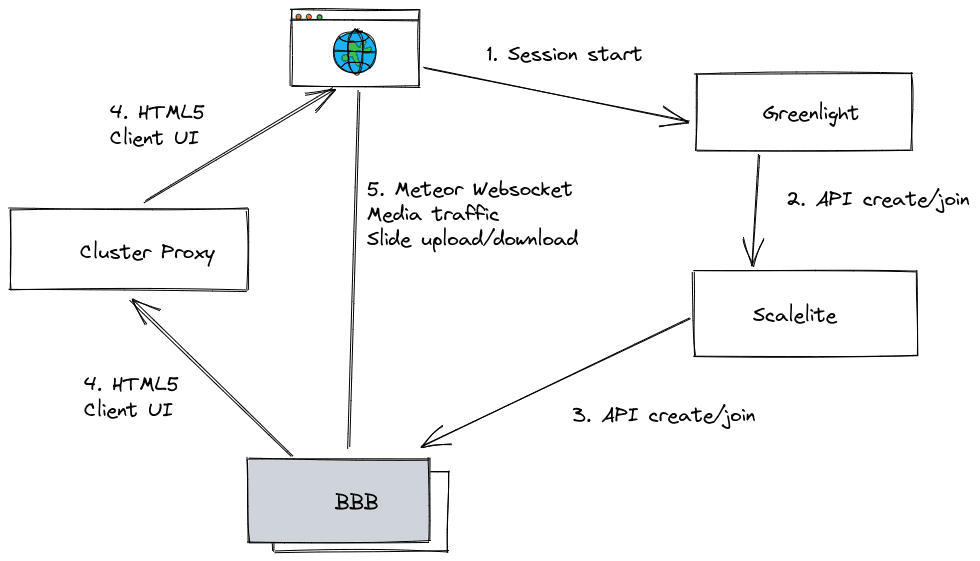Cluster Proxy Configuration
Motivation
In a traditional cluster setup, a scaler such as Scalelite is responsible for distributing new meetings and the joining users to one of the available BigBlueButton servers. While this setup is simple, it requires users to grant permissions for the access to microphones, videos and screensharing whenever a user gets assigned to a different server. This is due to the behavior of the getUserMedia() browser API call. This is a preventive measure that protects users so they will only grant access to servers they intend to. However in a cluster setup, each server prompts for permission individually. This is perceived as annoying or even erratic.
This document describes an approach to set up a BigBlueButton cluster in a way that will only prompt each user once per media type. To ensure horizontal scalability media traffic and web socket connections are directly exchanged between the user and the BigBlueButton server which runs the conference. This is achieved by relaying only the HTML5 client UI through a common proxy server.
Before diving into the details, it is important to emphasize what this solution is not:
- It is not a full reverse proxy for all BigBlueButton-related traffic. Browser and BigBlueButton server will still exchange most of the traffic directly.
- It is also not tied to Scalelite. You can choose any other BigBlueButton loadbalancer of your choice.
Note: The cluster proxy setup requires BigBlueButton 2.4.0 or later!
Basic principle
The following image visualizes the conceptual dependencies. Note that it is not a flow diagram.

Once a user starts or joins a meeting (1), Greenlight or another BigBlueButton
frontend will initiate a new meeting by calling the create and join API
calls on Scalelite respectively (2). Scalelite in turn will forward the API calls
to one of the BigBlueButton servers (3). The BigBlueButton server will advise
the browser to fetch the HTML5 client UI via the cluster proxy address. Thus,
the BigBlueButton server will appear as if it was hidden behind the cluster
proxy (4).
While assets like images, CSS and javascript files are loaded via the cluster proxy, all websocket, media streams and slides up/downloads are directly exchanged with the BigBlueButton server which runs the meeting (5).
Configuration
In this example, we will be using the following host names:
bbb-proxy.example.com: The cluster proxybbb-XX.example.com: The BigBlueButton servers (XXrepresents the number of the BigBlueButton server)
Proxy Cluster Server
In this example, we will use a simple nginx based setup. For each BigBlueButton server, add a new location directive. For the first node, this would be:
location /bbb-01/html5client/ {
proxy_pass https://bbb-01.example.com/bbb-01/html5client/;
proxy_http_version 1.1;
proxy_set_header Upgrade $http_upgrade;
proxy_set_header Connection "Upgrade";
}
location /bbb-01/bigbluebutton/api {
proxy_pass https://bbb-01.example.com/bigbluebutton/api;
proxy_http_version 1.1;
proxy_set_header Upgrade $http_upgrade;
proxy_set_header Connection "Upgrade";
}
Repeat this location directive for every BigBlueButton server.
You are free to choose any other HTTP reverse proxy software to fill the role of the reverse proxy in this setup.
As this is the user visible host name, you may want to pick a nicer hostname,
such as bbb-cluster.example.com. Make sure to adjust it in all places.
BigBlueButton Servers
For each BigBlueButton server in your cluster, repeat the following steps:
Add these options to /etc/bigbluebutton/bbb-web.properties:
defaultHTML5ClientUrl=https://bbb-proxy.example.com/bbb-01/html5client/join
presentationBaseURL=https://bbb-01.example.com/bigbluebutton/presentation
accessControlAllowOrigin=https://bbb-proxy.example.com
graphqlWebsocketUrl=wss://bbb-01.example.com/v1/graphql
Add the following options to /etc/bigbluebutton/bbb-html5.yml:
public:
app:
basename: '/bbb-01/html5client'
bbbWebBase: 'https://bbb-01.example.com/bigbluebutton'
learningDashboardBase: 'https://bbb-01.example.com/learning-dashboard'
media:
stunTurnServersFetchAddress: 'https://bbb-01.example.com/bigbluebutton/api/stuns'
sip_ws_host: 'bbb-01.example.com'
kurento:
wsUrl: wss://bbb-01.example.com/bbb-webrtc-sfu
presentation:
uploadEndpoint: 'https://bbb-01.example.com/bigbluebutton/presentation/upload'
# for BBB 2.4:
note:
url: 'https://bbb-01.example.com/pad'
# for BBB 2.5 or later
pads:
url: 'https://bbb-01.example.com/pad'
Create (or edit if it already exists) this unit override file:
/etc/systemd/system/bbb-html5.service.d/cluster.conf
It should have the following content:
[Service]
Environment=ROOT_URL=https://127.0.0.1/bbb-01/html5client
Environment=DDP_DEFAULT_CONNECTION_URL=https://bbb-01.example.com/bbb-01/html5client
Prepend the mount point of bbb-html5 in all location sections except for the
location @html5client section in /usr/share/bigbluebutton/nginx/bbb-html5.nginx:
location @html5client {
...
}
location /bbb-01/html5client/locales {
...
}
Note: It is important that the location configuration is equal between the BigBlueButton server and the proxy.
Add a route for the locales handler for the guest lobby. The guest lobby is served directly from the BBB node.
# /usr/share/bigbluebutton/nginx/bbb-html5.nginx
location =/html5client/locale {
return 301 /bbb-01$request_uri;
}
Create the file /etc/bigbluebutton/etherpad.json with the following content:
{
"cluster_proxies": [
"https://bbb-proxy.example.com"
]
}
Adjust the CORS settings in /etc/default/bbb-web:
JDK_JAVA_OPTIONS="-Dgrails.cors.enabled=true -Dgrails.cors.allowCredentials=true -Dgrails.cors.allowedOrigins=https://bbb-proxy.example.com,https://https://bbb-01.example.com"
Adjust the CORS setting in /etc/default/bbb-graphql-middleware:
BBB_GRAPHQL_MIDDLEWARE_LISTEN_PORT=8378
# If you are running a cluster proxy setup, you need to configure the Origin of
# the frontend. See https://docs.bigbluebutton.org/administration/cluster-proxy
BBB_GRAPHQL_MIDDLEWARE_ORIGIN=bbb-proxy.example.com
Pay attention that this one is without protocol, just the hostname.
Adjust the CORS setting in /etc/default/bbb-graphql-server:
HASURA_GRAPHQL_CORS_DOMAIN="https://bbb-proxy.example.com"
This one includes the protocol.
Reload systemd and restart BigBlueButton:
# systemctl daemon-reload
# bbb-conf --restart
Now, opening a new session should show
bbb-proxy.example.com/bbb-XX/html5client/ in the browser address bar and the
browser should ask for access permission only once.
Further Considerations
Security
If your proxy has access to internal machines, make sure that the reverse proxy
does not give access to websites on machines other than the BigBlueButton
servers. In the suggested configuration outlined above, this is not the case.
It might become an issue if you resort to e.g. regular expression-based
location directives in order to avoid adding one location per BigBlueButton
server.
Performance, Data Traffic and Role Separation
The BigBlueButton HTML5 is several megabytes in size. Make sure that the traffic between BigBlueButton servers and the cluster proxy server does not incur additional cost.
This setup introduces user visible single point of failure, i.e. a prominent DDoS target. Make sure your frontend server is resiliant to DDoS-attacks, e.g. has connection tracking disabled in its firewall settings and the web server is configured to handle enough connections. Those optimizations however are rather specific to individual setups and thus out of the scope of this document.
For the same reason, it is advisable to keep Scalelite on a different machine and to provide a HA setup for the proxy server (i.e. using IP failover or Anycast). Please monitor your setup carefully.